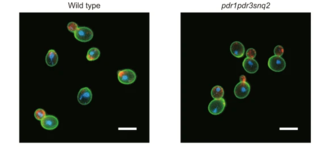High-throughput platform for yeast morphological profiling predicts the targets of bioactive compounds
S. Ohnuki et al. "High-throughput platform for yeast morphological profiling predicts the targets of bioactive compounds" npj Systems Biology and Applications 8 (2022) [DOI: 10.1038/s41540-022-00212-1]
Morphological profiling is an omics-based approach for predicting intracellular targets of chemical compounds in which the dose-dependent morphological changes induced by the compound are systematically compared to the morphological changes in gene-deleted cells. In this study, we developed a reliable high-throughput (HT) platform for yeast morphological profiling using drug-hypersensitive strains to minimize compound use, HT microscopy to speed up data generation and analysis, and a generalized linear model to predict targets with high reliability. We first conducted a proof-of-concept study using six compounds with known targets: bortezomib, hydroxyurea, methyl methanesulfonate, benomyl, tunicamycin, and echinocandin B. Then we applied our platform to predict the mechanism of action of a novel diferulate-derived compound, poacidiene. Morphological profiling of poacidiene implied that it affects the DNA damage response, which genetic analysis confirmed. Furthermore, we found that poacidiene inhibits the growth of phytopathogenic fungi, implying applications as an effective antifungal agent. Thus, our platform is a new whole-cell target prediction tool for drug discovery.
Full microscopy image data sets are available in SCMD (Saccharomyces cerevisiae morphological database.
